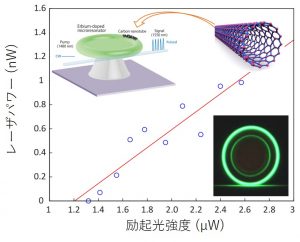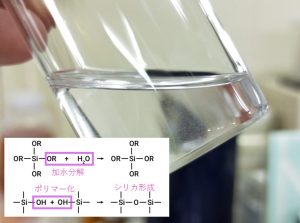Research Themes
Development of the world's smallest pulsed laser
- Contents
A laser can be fabricated by combining an optical resonator and a gain medium. If a micro optical resonator can have gain, it is possible to create aDeveloped a small laserThe following is an example of a case in which the use of the "M" in a product is possible. Therefore, thesol-gel methodusing a chemical process calledErbium-doped glass on silicon substrateThe micro laser was realized by processing erbium-doped glass to create a micro optical resonator.
We will further develop this laser toPulsed laser oscillationThe mode-locking method is used for this purpose. This requires a technique called mode-locking. In order to achieve mode-locking, a fast response is required.carbon nanotubeto the resonator to realize a mode-locked laser. If this can be achievedWorld's smallest ultrashort pulsed laserThe results are expected to be
The mode-locked laser is expected to have an output pulse repetition rate of well over 100 GHz, making it suitable for a wide range of applications. In particular, the mode-locked laser is expected to be particularly effective in processing new materials such as carbon fiber-reinforced plastics.High-speed laser processingThe high performance is expected to be obtained as a seed light source for

- Key Technology Points
Since the sol-gel method is a chemical processKnowledge of chemistryThe process of finding the optimum conditions by shaking a test tube is a patient and time-consuming task. Finding the optimum conditions by shaking test tubes is a patient and time-consuming process. It is also a difficult process that requires adjustment of the recipe from time to time, even once conditions have been found, as they are easily affected by humidity and temperature.
Various studies are also needed to determine how to synthesize the carbon nanotubes necessary for mode-locking and how to attach them to the microcavity. Furthermore, it is necessary to determine whether the desired performance can be obtained.Optical MeasurementIt is not easy.

Since there is no precedent for mode-locking with such a small resonator, the amount of erbium doping and the performance of the required carbon nanotubes are not yet clear. We have set up a rigorous model andnumeric calculationThe design parameters are being clarified by doing
As the research topics are diverse, including the construction of physical models, investigation of parameters by computer simulation, development of fabrication technology for micro optical resonators by the sol-gel method, and synthesis and deposition of carbon nanotubes, the team is working on the research while sharing roles.
- Research Projects
Since this research requires a variety of elemental technologies, it is reallyWe are conducting our research with the cooperation of many institutions....
For laser oscillation using erbium-doped glass, we are receiving advice from Prof. Lan Yang of the University of Washington and Prof. Fujiwara of the Department of Chemistry. For carbon nanotubes, we are collaborating with the Yamashita-Set laboratory of the University of Tokyo, which is a leader in the development of mode-locked lasers for carbon nanotubes, and the Maki laboratory of the Department of Physics and Information Engineering, which specializes in synthesis.
This laser has the potential to be used for high-speed laser processing and is supported by the Amada Foundation of Amada Holdings Co. In addition, we are conducting research while participating in the MEXT's Q-LEAP project, in which the University of Tokyo, RIKEN, and many other research institutes are participating.
《 Keyword 》
Research Themes
- What is Professor Tanabe's education?
- About Research at Tanabe Lab.
- Must see! Laboratory Introduction Video
- Dig Deeper TANABE Lab.
- You get a good idea of what the lab is like!
- Laboratory Information Session for FY2024 Assignees
We are holding a lab information session for students who will be assigned in 2024. Open Labs are free to come and go as they please. Individual information sessions are also available at any time.
.
- 10/23 (Mon) 16:30- Briefing Session 1 (Location: Bldg. 14, 2F DS43)
- 10/27 (Mon) 18:00- Explanatory Session 2 (Location: Bldg. 14, 2F DR8)
- 11/ 2 (Thu) 16:30- 3rd briefing (Location: 14th Bldg., 2F DR7)
- Laboratory tours and open labs (as needed)
Individual Information Sessions and Lab Tours













